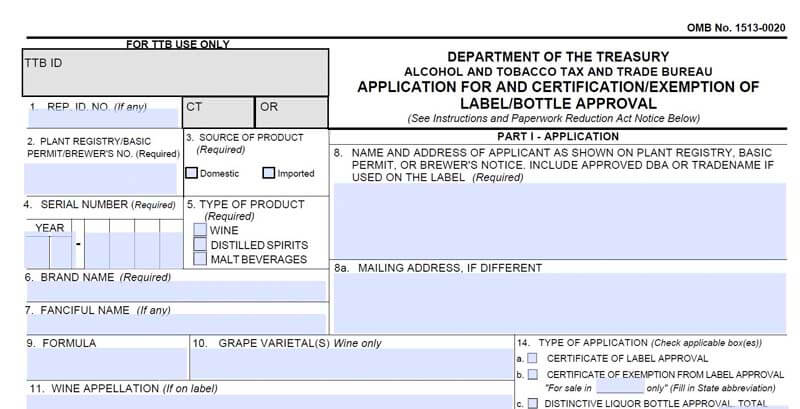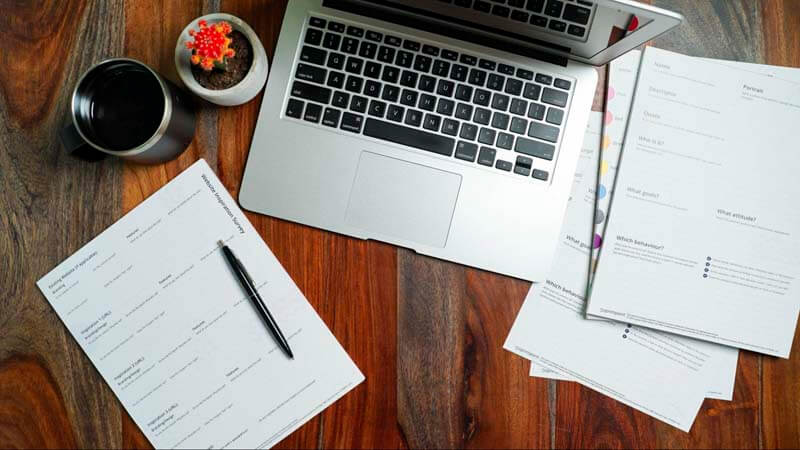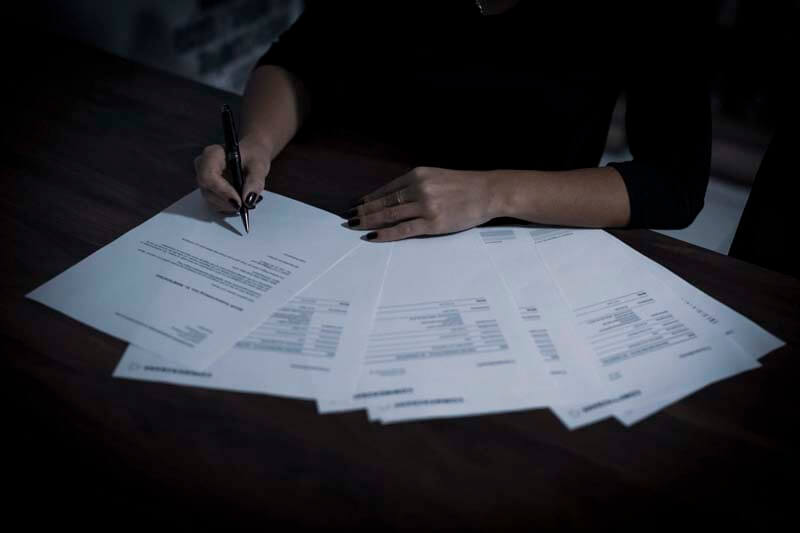As a brewery owner, you’ve probably filled out many Certificate of Label Approvals (COLAs), so maybe it’s second nature by now.
But have you had one, two, or too many rejected by the The Alcohol and Tobacco Tax and Trade Bureau (TTB)?
That’s because there are many nuances and complexities to consider when getting a label federally approved.
So how can you streamline applying for a COLA? And what tips and tricks can you use to get your COLA approved faster?
We chatted with Emily Lyons, attorney in Husch Blackwell’s Washington, D.C., office and member of the firm’s Food & Agribusiness industry group and Alcohol & Beverage practice team, and Daan Erikson, attorney in Husch Blackwell’s Chicago office and member of the firm’s Food & Agribusiness industry group and Intellectual Property practice team, to get you the answers.
(Above photography courtesy of Corona Radiata | Zazzle)
What We’ll Cover in This Piece:
What Exactly Is a COLA?

COLA form label | Image courtesy of The Alcohol and Tobacco Tax and Trade Bureau (TTB)
The TTB requires every brewery to obtain a Certificate of Label Approval (COLA) before adding any markings to any kegs, cans, bottles, or packaging of any kind.
“Basically, it is a pre-market review of a label to ensure that it has all the required elements in order to meet the labeling regulations issued by the TTB,” says Lyons. “Because alcohol is such a highly regulated product, [a COLA] is a way for TTB to make sure that alcoholic beverage companies and brewers are making truthful, not misleading claims and providing all the necessary information to consumers.”
COLAs are a legal requirement, so it’s important to understand how to apply for one and, perhaps most importantly, tips for ensuring a smooth application process.
What You’ll Need to Apply for a COLA

Photography courtesy of 2h Media | Unsplash
Before even applying for a COLA there are a couple things you need in place.
Obtain a Brewer’s Notice
First, you need a brewer’s notice from the TTB. Basically a federal manufacturing registration, a brewer’s notice authorizes a brewer to produce beer for sale.
You’ll need this brewer’s notice in order to access the TTB’s COLAs Online system, an electronic portal for filling out COLA applications.
Make a Label
This seems like a silly step, but it’s completely logical. The TTB requires you to submit a JPG or PNG file of your actual label on your COLA application.
You can’t apply for a COLA without having a finalized label design.
Our piece on Craft Beer Labeling: What Makes a Good Craft Beer Label? covers the TTB’s label requirements extensively, but here are the basic requirements:
- Brand name
- Class and type designation (beer, ale, IPA, stout, etc.)
- Name and address (of the bottler or packer)
- Net contents
- Alcohol content
- Mandatory health warning labels
Fill Out an Application
There are two ways to fill out a COLA application: a paper application that you can mail to the TTB or through the TTB’s COLAs Online system.
“I would say one hundred percent of my clients and probably eighty percent of individuals submit COLAs through COLAs Online,” says Lyons. “It’s the fastest way for the TTB to review them because you electronically upload the information.”
If you are looking for a comprehensive guide on creating an application to file an electronic COLA application, we highly recommend reading the TTB’s guide to creating an application.
5 Ways to Get Your COLA Approved Faster

Photography courtesy of Shablon
Having submitted hundreds of COLAs at this point, Lyons has some advice on how to get your COLA approved faster.
1. Use COLA’s Online
Using this electronic portal reduces the time it takes to send paper applications through the mail.
Plus, the TTB actually runs a handy site that keeps track of up-to-date processing times. At the time of publication, a malt beverage label will take five days to process, according to the TTB.
Another advantage to submitting an electronic application is that, if the TTB does find something wrong, they will notify you and give you a thirty-day grace period to make those corrections. Those edits can easily be made in the COLAs Online system. During that time you will keep your place in the queue, ensuring that your application gets approved faster.
If you fill out a paper application and the TTB finds something wrong with it, they will simply deny your application and you’ll need to start over, filling out everything from the beginning.
2. Submit Your Label Image as a JPEG or PNG File
Lyons says one of the most common mistakes she sees brewers make is uploading their label image in a file format the TTB does not support.
“Make sure you have the label provided in the correct format and correct size,” says Lyons.
The TTB only accepts either JPEG (.jpg, .jpeg) or PNG (.png) file formats. TIFF files are not accepted, nor are PDFs.
Plus, files can not exceed 1.5MB and should be at a resolution of at least 120-170 dpi.
The TTB recommends that JPEG files are of a “Medium” compression/quality ratio (7 out of 10 or 70 out of 100).
“I will tell you, this takes the longest because they want a high-quality image, but they need to be small [enough] to upload to the database,” says Lyons. “It can get complicated when, if I’m submitting for someone or someone is submitting themselves, they’ll get rejections because their upload was too big.”
3. Pay Attention to All the Required Details on Your Labels
“Do you have all the required elements?” says Lyons. Missing out on label regulations from the TTB will be a sure way to increase the time it takes to get your COLA approved.
And yes, these can be very small but absolutely crucial requirements.
For example, “everyone will include the surgeon’s general warning about consumption of alcohol, but sometimes they’ll forget a colon or period or something like that and the TTB expects it to be done exactly the way it’s issued in the regulations,” says Lyons. “It has to be exact: bolded, large font, all those things. So make sure that’s followed.”
Other common label problems Lyons has seen include forgetting the type or class designation. “We know it’s a beer or a malt beverage, but I need to know, is it a rye? Is it an ale? What is it actually?” says Lyons. “Sometimes that gets accidentally left off these types of product [labels].”
Overall though, the biggest thing to remember with your label designs is that all the label statements required by the TTB are legible. “We have beautiful craft beer labels now,” says Lyons. “But sometimes we have to be really careful about ensuring the label statements, especially the required ones, are clear and conspicuous—not just meeting the appropriate type font sizes, but also making sure the text is readable.”
According to Lyons, she’s run into problems with COLA applications where the TTB will come back and tell her they can’t read something like a white text on a beautiful background. In these cases, the beverage company needs to find a way to make the text more readable for the consumer.
“Because [the TTB] does that truthful and not misleading review, they need to know what [your label] says,” explains Lyons.
Lyons’ best piece of advice here? Use the TTB’s Beverage Alcohol Manual (BAM) to ensure you’re checking all the legal requirement boxes on your label.
4. Be Prepared for All Keg, Can, Bottle, and Packaging Sizes
Here’s a zinger for you: You need to fill out a COLA application for each size of label used.
What does that mean exactly?
Let’s say you’re packaging a beer in 12oz cans but also 16oz tall boys, kegging it for draft, and packaging those 12oz cans in a carton.
You’ll need to fill out at least four COLAs—one for each of those packaging types.
“If you change the format size, you’re going to have to potentially adjust things around on your label,” says Lyons. “Because a [COLA] is based on dimensions of your product and not just the label design itself,” you’ll need to fill out an application for each uniquely sized label.
Even the outer packaging on cans or bottles needs a separate COLA approved.
Or if you have a back and front label on a bottle, you’ll need to fill out two separate COLAs for both.
Once again, the TTB wants to review that you’re being truthful and not misleading on all these packaging formats.
Sounds confusing? It can be.
Which is why you should consider getting advice from a professional.
5. Hire a Professional
Nailing these intricate details is why Lyons strongly recommends working with a professional to fill out your COLA applications.
You can certainly handle uploading your labels and filling out an application yourself, but someone who is trained in all the intricacies of the system can be invaluable to avoiding mistakes and getting your COLAs approved faster.
“It’s important to work with someone who understands what’s required and the ways it needs to be done,” says Lyons.
The TTB requirements can be a little finicky and the fine print can get a little tricky, so having somebody on your team that has dealt with these challenges before can ultimately save you time in the long run.
We Answered 11 FAQs About COLAs

Photography courtesy of Dimitri Karstelev | Unsplash
We found the answers to some commonly asked questions about COLAs.
How long does it take to get a COLA approved?
The processing times can differ on any given day and whether you’re applying for a COLA for a malt beverage, distilled spirit, or wine. But the TTB displays its up-to-date processing times here.
Currently, a COLA for distilled spirits and malt beverage labels takes five days while one for wine labels takes two days.
What does it cost to fill out a COLA?
Nothing!
COLAs are free to fill out. Unlike applying for a trademark, which includes an application fee, COLAs come free of charge.
What file formats Does COLAs Online accept for label images?
This is extremely important to remember: COLAs Online only accepts label images in either JPEG (.jpg, .jpeg) or PNG (.png) file formats.
TIFF files are not accepted, nor are PDFs.
What is the limit on file size for label images?
Files can not exceed 1.5MB and should be at a resolution of at least 120-170 dpi.
The TTB recommends that JPEG files are of a “Medium” compression/quality ratio (7 out of 10 or 70 out of 100)
What do you need if you’re submitting a claim like “organic,” “gluten free,” etc.?
The TTB requires additional documentation if you’re making claims on your label such as “organic,” “gluten free,” “biodynamic certified,” etc.
In Step 3 of your COLA application, you will upload any and all documents acknowledging approval of any claim you’re making.
You can use the following file types: DOC(.doc, .docx), TEXT(.txt), PDF(.pdf), or JPEG (.jpg, .jpeg, .jpe).
The TTB allows you to upload up to 10 files, but each must not exceed 750KB.
What if I have foreign languages on my label?
All required information has to be presented in English.
Generally, beer styles in other languages (such as kölsch, hefeweizen, etc.) are acknowledged as styles, so those are fine to list as your type and class designation.
But if you’re including other information on the label about the product that the TTB needs to read, it has to be presented in English. Otherwise, you need to send the TTB the English translation.
“That way [the TTB] can say, yes, you’re not lying to people in German, [for example],” says Lyons.
What if I’m a contract brewer or have an alternating proprietorship?
Great question!
In the case of a contract brewer, the COLA is submitted by the person who holds the federal basic permit.
For an alternating proprietorship, where two people hold different permits at the same location, the COLA will be submitted by whomever is producing under that relationship and permit.
“That is why it’s extremely important to have a contract with a contract brewer or alternating proprietorship that outlines who owns the COLA, especially if you get to a point where you’re moving production elsewhere or building your own facility, which is always the dream,” says Lyons.
Is a COLA the same as a trademark?
No.
“This happens all the time when people think ‘I’ve got my registration so therefore I’m registered for every type of registration there is,’ and of course that’s not true,” says Daan Erikson, attorney in Husch Blackwell’s Chicago office and member of the firms’ Intellectual Property practice team. “A COLA is not a trademark registration; it doesn’t give you registered protection in the brand names on the label in a trademark sense.”
Looking for more on trademark registration? Check out our piece here.
How can you check the status of your COLAs Online form?
When using COLAs Online, you can always check the status of your application through the “Home: My eApplications” page.
What’s the difference between an application that “Needs Correction” and “Rejected”?
If something needs to be updated on an application, the TTB will return it with the status “Needs Correction.”
You don’t get this step with a paper submission, so another great reason to use COLAs Online.
An application that “Needs Correction” affords the brewery thirty calendar days from that date to make corrections.
Essentially, you get to keep your place in the queue as you make those changes.
A “Rejected” application on the other hand means the TTB has denied your application. If you file a paper application, it may be rejected right off the bat because you are missing essential federal requirements.
The main reason why an electronic application would be rejected is if you let that thirty-day period lapse before making the necessary corrections.
If that happens, you will then need to resubmit your application all over again and go all the way back to the end of the queue.
It is far easier to just make the necessary changes while your application is still in play than to start all over from the beginning.
What happens once your COLA is approved?
Well, there aren’t exactly fireworks. But the TTB will email you a link to download your approved COLA.
Now you can use that label and distribute products in interstate commerce.
Basically, “once you have your COLA you can start canning!” says Lyons.
Didn’t find the answer to your question here? Check out the TTB’s COLAs and Formulas Online FAQs.
Brew Your Best Beer. Get Ollie.
A brewery management tool built by brewers and for brewers. Handle everything in your brewhouse from recipe development to cost management. All with one easy-to-use platform. Request a free demo today.



